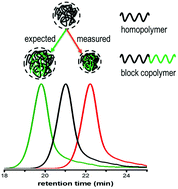The block copolymer shuffle in size exclusion chromatography: the intrinsic problem with using elugrams to determine chain extension success
Abstract
Size exclusion chromatography (SEC) based on direct homopolymer calibration is the preferred method for molecular weight determination in macromolecular synthesis. However, using the same method and calibration in block copolymer (BCP) characterization can lead to an apparent molecular weight reduction when in fact the opposite has taken place. This leads to a situation where researchers often have enough difficulties in interpreting their data, creating false conclusions and deeming successful experiments unsuccessful or vice versa. Here, a selection of block copolymers from the literature is discussed for which such an incoherent change in the retention time has been observed. These examples represent four categories of BCPs for which unexpected SEC results can occur. We discuss the importance of a critical evaluation of SEC and the reasons for the deviating behavior and highlight the danger of the common practice to use elugrams to prove or disprove successful chain extensions in synthesis. Next to a critical evaluation of the various cases, we give recommendations for which other detection and characterization methods may enable accurate block copolymer characterization.



 Please wait while we load your content...
Please wait while we load your content...